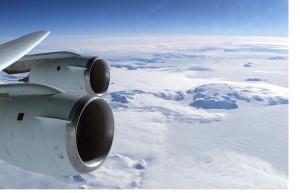SATURDAY, 4 JUNE 2011
 Antarctica has had a long history of ice sheet expansion and retreat. The continent separated from South America with the opening of the Drake Passage around 41 million years ago, allowing the evolution of the circumpolar current [1]. 34 million years ago ice sheets began to form as a result of rapid global cooling and declining carbon dioxide levels, but the nature of the substrate underneath the ice has not been fully explored.
Antarctica has had a long history of ice sheet expansion and retreat. The continent separated from South America with the opening of the Drake Passage around 41 million years ago, allowing the evolution of the circumpolar current [1]. 34 million years ago ice sheets began to form as a result of rapid global cooling and declining carbon dioxide levels, but the nature of the substrate underneath the ice has not been fully explored.A collaboration of scientists from the United Kingdom, United States and Australia has produced a detailed map of the basal topography of the East Antarctic Ice Sheet [2]. The team took a series of flights in a ski-equipped 1942 Douglas DC-3 fitted with ice-penetrating radar, and found a complex surface of mountains and fjords sculpted from a succession of ice sheets that are quite different from those found today. In fact, some of the ice growth and decay are likely to have required surface melt and therefore temperatures much higher than in Antarctica at present.
High resolution mapping of Antarctica is difficult and expensive, but helps scientists understand the continent's history. Accurate topographical data will also improve models of ice flow so they can better predict how it will respond to future changes in temperature [3].
Written by Robert Jones
References:
- http://www.research.ufl.edu/publications/explore/v11n2/extract4.html
- Young, D. A., Wright, A. P., Roberts, J. L., Warner, R. C., Young, N. W., Greenbaum, J. S., Schroeder, D. M., et al. (2011). A dynamic early East Antarctic Ice Sheet suggested by ice-covered fjord landscapes. Nature, 474(7349), 72-75. doi:10.1038/nature10114
- http://www.bbc.co.uk/news/science-environment-13616725
